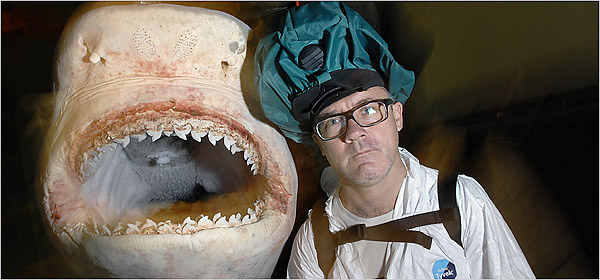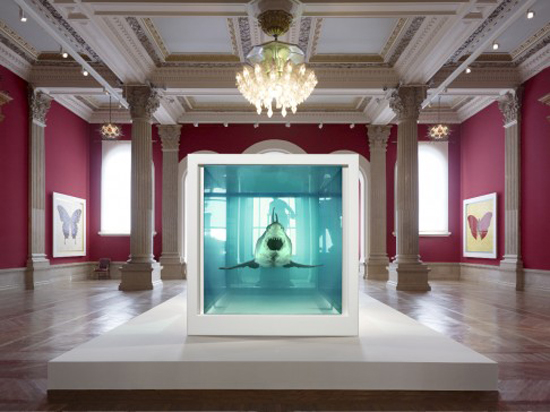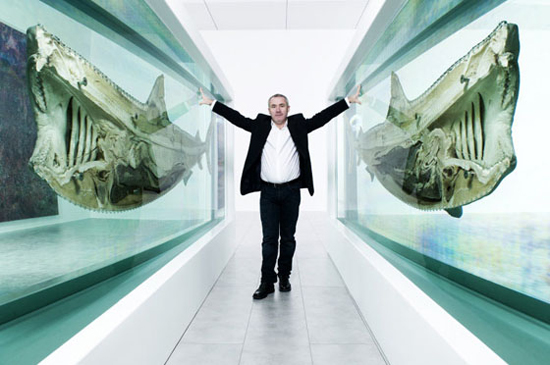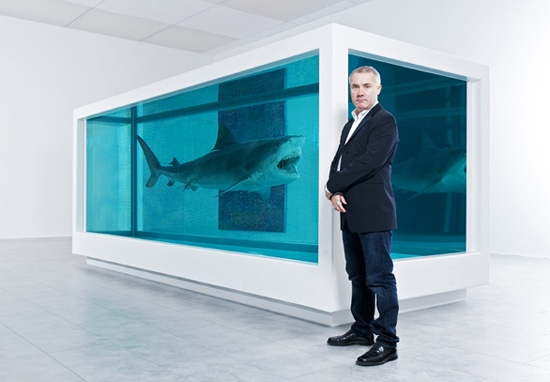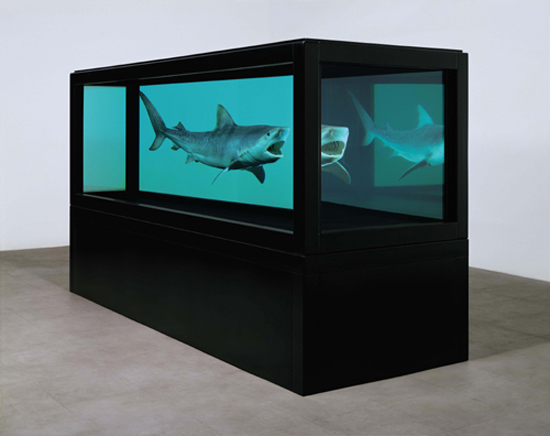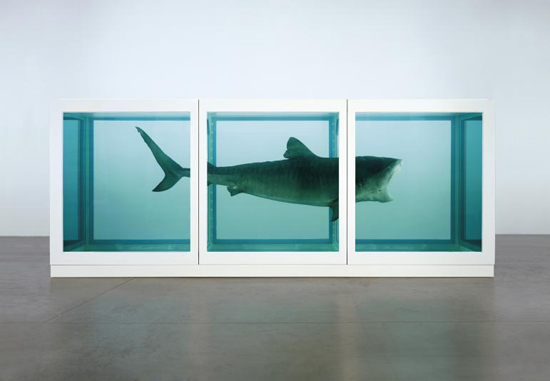
Sono stato alla mostra di Damien Hirst alla Tate Modern di Londra. È una mostra all’altezza sia della Tate sia di Hirst. Se potete, non perdetevela. L’opera più bella è anche la più famosa: The Physical Impossibility of Death in the Mind of Someone Living (d’ora in poi per brevità TPIODITMOSL).
Di quest’opera Hirst ha parlato molte volte (l’ultima qui), ma una volta ha spiegato: “Mi piace l’idea di qualcosa che descrive una sensazione. Uno squalo fa paura, è più grande di te, si muove in un ambiente a te sconosciuto. Sembra vivo quando è morto e morto quando è vivo”.
Nella mostra di Londra, però, gli squali esposti sono due. Il primo è, appunto, TPIODITMOSL. L’altro, più piccolo e in una teca nera, si intitola The Kingdom.
Per molti TPIODITMOSL è diventato il simbolo della follia dell’arte contemporanea, tanto che nel 2008 l’economista Donald Thompson ha scritto un libro tradotto in italiano col titolo Lo squalo da 12 milioni di dollari – La bizzarra e sorprendente economia dell’arte contemporanea. Thomson racconta per filo e per segno la genesi di TPIODITMOSL e rivela una serie di particolari abbastanza interessanti.
L’opera fu realizzata per la prima volta nel 1991 con i soldi di Charles Saatchi. “L’artista – racconta Thompson – aveva fatto alcune telefonate “Cercasi squalo” ad alcuni uffici postali australiani in località costiere, i quali avevano appeso dei cartelli con il suo numero di Londra”. A rispondere all’annuncio fu Vic Hislop, un pescatore di Hervey Bay, una località sull’Oceano Pacifico. Lo squalo fu pagato 6000 dollari: 4000 per la cattura e 2000 per imballarlo nel ghiaccio e spedirlo a Londra via nave.
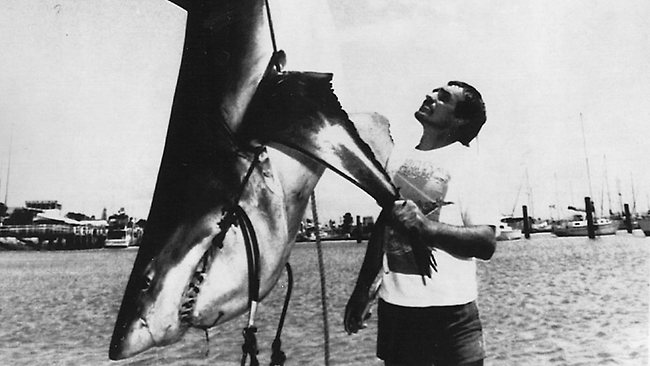
TPIODITMOSL fu esposta per la prima volta nel 1992 nella galleria privata di Saatchi. Quando però nel 2005, tramite i buoni uffici di Larry Gagosian, Saatchi vendette l’opera al finanziere americano Steve Cohen (si dice per 12 milioni di dollari), lo squalo si era completamente deteriorato. Hirst accettò si sostituire l’animale e chiamò di nuovo Vic Hirslop. Gli chiese altri tre squali tigre e un grande squalo bianco della stessa stazza e ferocia dell’originale. Hirslop, racconta Thompson, inviò a Hirst cinque squali, uno dei quali in regalo. (Qui l’articolo del Nyt che racconta la sostituzione di squalo)
Che fine hanno fatto gli altri quattro squali? In realtà io ne ho censiti almeno cinque. Eccoli:
The Immortal (1997-2005)
The Wrath of God (2006)
Death Explained (2007)
Death Denied (2008)
The Kingdom (2008)
Che io sappia poi, esiste almeno un’opera realizzata anziché con uno squalo, con un pesce-martello:
Fear of Flying (2008-2009)
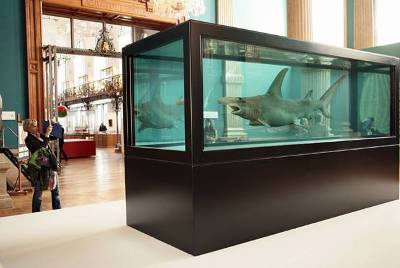 |
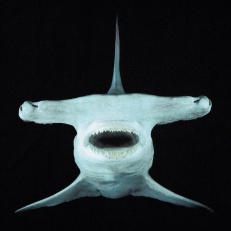 |

I’ve been to Damien Hirst’s exhibition at the Tate Modern in London. It is a show worthy of the Tate and Hirst. The most amazing work is the most famous one: The Physical Impossibility of Death in the Mind of SomeoneLiving (hereafter for brevity TPIODITMOSL).
Hirst spoke about this work many times (the last one here), but once explained: “I like the idea of something describing a feeling. A shark is scary, it’s bigger than you, it moves in a environment unknown to you. It seems alive when it is dead, and dead when it is alive”.
In the London show, however, the sharks on display are two. The first is, in fact, TPIODITMOSL. The other, smaller and in a black vitrine, called The Kingdom.
For many TPIODITMOSL has become the symbol of the folly of contemporary art, so much so that in 2008 the economist Donald Thompson wrote the book The $12 Million Stuffed Shark. Thomson explains the genesis of TPIODITMOSL and reveals a number of quite interesting details.
The work was realised for the first time in 1991 with Charles Saatchi’s money. “The artist – writes Thompson – had made some phone calls “Wanted shark”at some post offices in the Australian coastal towns, which had hung signs with his number in London”. The man who called Hirst was Vic Hislop, a fisherman from Hervey Bay, a resort on the Pacific Ocean. The shark was paid $6000: $4000 for the capture and $2000 for packing it in ice and shiping it to London by ship

TPIODITMOSL was shown for the first time in 1992 in Saatchi’s private gallery. But when in 2005, through the good offices of Larry Gagosian, Saatchi sold the work to the American financier Steve Cohen (they say: 12 million dollars), the shark had completely deteriorated. Hirst accepted to replace the animal and called again Hirslop Vic. He asked three other tiger sharks and great white shark of the same size and ferocity of the original. Hirslop, says Thompson, sent five sharks, one of them as gifts. (Here the article in the NYT with the story of the replacement of the shark).
What happened to the four other sharks? I actually counted at least five. Here they are:
The Immortal (1997-2005)
The Wrath of God (2006)
Death Explained (2007)
Death Denied (2008)
The Kingdom (2008)
Then as I know, there is at least a work created instead wiht a shark, whit a fish-hammer:
Fear of Flying (2008-2009)
 |
 |
